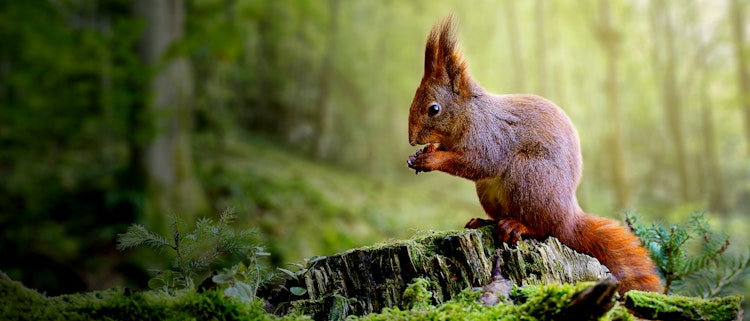Winter Wildlife at Bowyers Wood – Building the Baseline Before Beavers
A winter visit to Bowyers Wood reveals foxes, deer, herons and river life as Ecotalk carries out vital surveys, laying the groundwork for beavers and future nature recovery.

Until the 19th century, the red squirrel was considered a quintessential symbol of the British countryside. With bright eyes, a rusty red coat, a bushy tail and ear tufts pricking up, not to mention a sensible habit of stashing nuts in hollow trees, they were real little characters – as exemplified in Beatrix Potter’s illustrations of Squirrel Nutkin.
Red squirrels still have all that exuberance, but have suffered a terrible decline since the 1870s, when grey squirrels brought to Britain from North America escaped into the wild and began outcompeting the reds for territory. At Ecotalk, we’re planning to reintroduce red squirrels at our Boyers Wood project, giving them a foothold to return to the area.
As well as taking food sources and space from the red squirrel, grey squirrels also carry the squirrel pox virus. While it doesn’t affect the grey species, it is deadly to red squirrels. However, conflict between the species is only part of the story. Like so many other native species, the red squirrel has suffered from the depletion of its habitat.
By clearing Britain’s woodlands for agriculture, timber and firewood, over the last few centuries humans have made it harder for our red squirrel population to survive. With woodlands separated by roads, farms and development, most of Britain’s red squirrels live in the conifer forests of the Scottish Highlands and North Wales. Only about 140,000 remain, compared to 2.5 million grey squirrels.
However, before the grey squirrel’s arrival, red squirrels made their homes in both broadleaf and conifer forests, playing an important role in the ecology of woodland across the country by spreading tree seeds. By doing so at Cwm Uchaf, our red squirrels will help us rewild and maintain a healthy population of native tree species.
At Ecotalk we’re proud to offer customers a top-notch mobile phone service with a green outcome, but in this case we’re aiming for a red outcome.
Species: Eurasian red squirrel
Scientific name: Sciurus vulgaris
Length: 18 to 24cm
Weight: Up to 350g
Young: 2 to 4 kits
Territory: 7 hectares
Status: Protected
If you're not already an Ecotalk customer and helping British species like the red squirrel recover is something you'd like to support, visit the Our Deals page of the site and switch to the world's greenest mobile service.